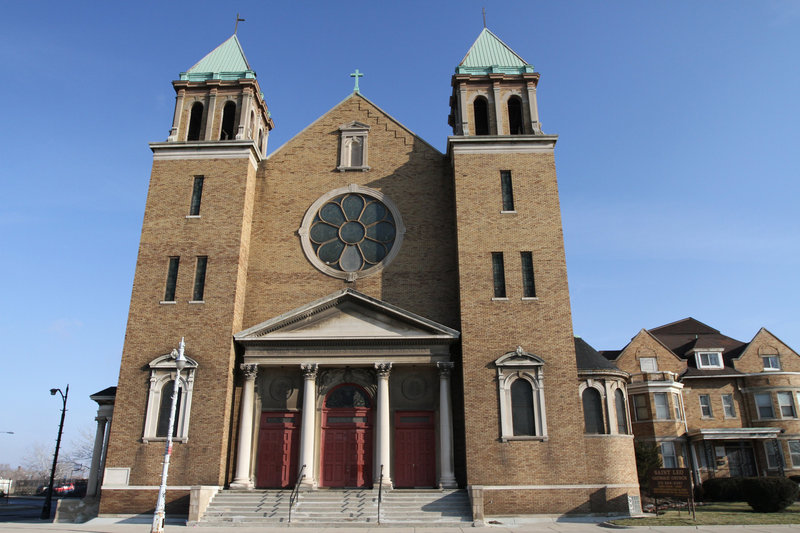DETROIT – On the east side of Detroit, the Nativity of Our Lord Catholic Church is the anchor of a neighborhood that has seen the addition of 14 new homes and a 62-unit senior center.
Joyce Anderson, an administrative assistant for the Wayne County Prosecutor’s Office, moved into a new house two years ago, in part, because of Nativity’s outreach in the neighborhood.
Now Nativity is fighting a recommendation that calls for the parish, and three others on the east side, to close.
“The church is really the reason I’m here. They were building up the community,” said Anderson, 56, who is not Catholic. “If they closed, all the positive energy would go with them.”
“If Nativity leaves,” Anderson said, “I’m gone.”
Detroit Archbishop Allen Vigneron of Detroit is reviewing recommendations to close up to 20 churches in Detroit, Highland Park and Hamtramck, and about 30 more in the suburbs. The pending closures — which are expected to be finalized this month — could shrivel the church’s urban footprint to nearly one-third of the 112 parishes that existed in Detroit and its enclaves in 1988.
Since 2000, about 25 parishes have closed in Detroit and the surrounding suburbs. Recently, at least seven parishes in the suburbs have decided to close or merge in the next year or two. But unlike the pending suburban closures, many of the urban parishes didn’t ask to be closed.
Many of the threatened urban parishes provide services to poor and homeless people. They are beacons of stability. And they are fighting to stay open.
“If it is providing food services, helping the homeless, closing (a church) is really a symbolic death knell of a neighborhood,” said demographer Kurt Metzger, who directs Data Driven Detroit and shared population trends and statistics with the Archdiocesan Pastoral Council, which made the closure recommendations.
“Whether they’re Catholic or not, people view the churches as community magnets and a community resource,” Metzger said. “When the church goes — in many cases — it’s the last thing there.”
Archdiocese statistics show about 10,000 Catholic households live and worship in Detroit, while 7,700 Catholic households commute from the suburbs to urban churches. But the city’s churches were built for Detroit’s boom times — when half the population was Catholic.
“It’s just a tough problem. These Catholic parishes were built to last, with magnificent churches. The vision coming over from Europe wasn’t that it would be a two- or three -generation or 50- or 70-year project,” said John McGreevy, a history professor and dean at the University of Notre Dame who wrote the book, “Parish Boundaries,” which dissects the Catholic church’s involvement in the civil rights movement.
“With white flight from Detroit, and a population decrease independent of white flight,” he said, “it’s been hard to figure out how to sustain them.”
Metzger said closing the urban churches also diminishes the link between the city and suburbs. Those churchgoers who drive from the suburbs are “so tied because they got baptized or got married there, even as they’ve abandoned the city,” he said. “Closing a church is another psychological blow, and they could sever all ties with the city.”
Like many issues confronting metro Detroit, the pending church closures are also underlined by a question of race: Many of the struggling congregations are primarily African American.
“They’re whistling in the wind if they think everybody at one parish will go to another,” said Camille Douglas, a member of the Church of the Madonna.
“It’s not the first time that urban black parishes are being closed. Some of our parishioners have had two or three parishes close underneath them. It’s more likely they’ll stop attending a Catholic church.”
Madonna — the parish from which the late Father William Cunningham helped found the social services agency Focus: HOPE — is on the chopping block.
Madonna has suffered in attendance following Cunningham’s death in 1997 and has been without a full-time pastor much of that time.
“Regrettably, we don’t have a time machine to go back in time 50-60 years. We don’t have a treasury to print money,” said archdiocese spokesman Ned McGrath. “Decisions that need to be made will be, more often than not, difficult. But each and every one is being made in an effort to secure Catholic faith communities and their presence in southeast Michigan.”
Before the Archdiocesan Pastoral Council made its recommendations in November, its members met with groups of parishioners, who had been coming up with ways to deal with the priest shortage.
The archdiocese deluged the parishioners with statistics showing population loss, job loss, foreclosure rates and other data to better assess a parish’s long-term outlook.
But some of those who participated in the meetings say the archdiocese ultimately ignored parishioners’ ideas and hard work.
Send questions/comments to the editors.



Success. Please wait for the page to reload. If the page does not reload within 5 seconds, please refresh the page.
Enter your email and password to access comments.
Hi, to comment on stories you must . This profile is in addition to your subscription and website login.
Already have a commenting profile? .
Invalid username/password.
Please check your email to confirm and complete your registration.
Only subscribers are eligible to post comments. Please subscribe or login first for digital access. Here’s why.
Use the form below to reset your password. When you've submitted your account email, we will send an email with a reset code.